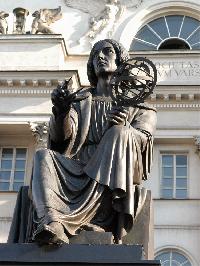On
the defectiveness of the argument for the finality of the discovery of
the remains of Nicolaus Copernicus.
Part 2.
Results and interpretation of genealogical, historical and genetic
research.
Click the title to download the file (949 KB pdf).
The article was peer-reviewed by:
- Professor Karolina Targosz, Habilitated Doctor in Humanities (Ludwik and Aleksander Birkenmajer Institute for the History of Science, Polish Academy of Sciences) — historical issues, Copernican iconography;
- Professor Tadeusz Dobosz, Habilitated Doctor in Medical Sciences (Department of Molecular Techniques, Chair of Forensic Medicine, Faculty of Medicine, Medical Academy in Wrocław; a member of the Forensic Genetics Commission of the Polish Society of Forensic Medicine and Criminology) — the issues of DNA analyses;
- Reverend Zbigniew Liana, PhD (Departament of Natural Sciences, Philosophical Faculty, Pontifical University of John Paul II) — methodological issues.
Published in:
Michał Kokowski (ed.), The
Nicolus Copernicus grave mystery. A dialog of experts.
(2015), pp. 209–304.
This paper was published originaly in Polish in:
Michał Kokowski (red.), Tajemnica
grobu Mikołaja Kopernika. Dialog ekspertów
(Kraków 22–23 II 2010) (2012), pp.
217–314.
ABSTRACT
The article presents a comprehensive critique of the argument in favour of the discovery of the remains of Nicolaus Copernicus. It analyses the arguments based on genealogical, historical and most of all genetic considerations, including the mathematical fundamentals of estimation a random match of mtDNA profiles.
The following assertion results from the presented criticism: Based on the results provided by the team of Jerzy Gšssowski, it is not possible to reasonably claim that the grave of Nicolaus Copernicus was discovered. Therefore, this research should be continued in order to increase the strength of the argument and obtain new evidence.
Keywords: Nicolaus Copernicus, Copernicology, likenesses of Copernicus, Copernicus’s ethnicity, genealogy, mtDNA, Y-DNA, mtDNA and Y-DNA population bases, methods for estimating the probability of a random match of mtDNA profi les for the general case and the extreme cases, genetic genealogy, ethnogenesis of Slavs and Germans, ethnic origin of the population of Silesia, ethnic origin of the Toruń burghers, methodology of interdisciplinary research.
See:
On the defectiveness of the
argument for the finality of the discovery of the remains of Nicolaus
Copernicus. Part 1.
It is worth noting that:
- the author of the article is the only Polish person who holds a doctor degree and a higher one called in Poland “doktor habilitowany” (habilitated doctor) in the field of Copernican studies — see Thomas S. Kuhn and the issue of the Copernican revolution (“Studia Copernicana”, vol. 39 2001) and Copernicus's Originality. Towards Integration of Contemporary Copernican Studies (Warsaw-Cracow 2004);
- he is also the actual co-author and one of the signatories (on behalf of the Polish Academy of Arts and Sciencs) of the so-called Frombork Declaration to encourage further research and competent popularization of achievements of Nicolaus Copernicus.
|
|






